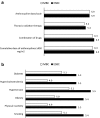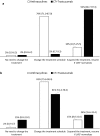Evaluation and management of chemotherapy-induced cardiotoxicity in breast cancer: a Delphi study
- PMID: 27101413
- PMCID: PMC5215075
- DOI: 10.1007/s12094-016-1508-y
Evaluation and management of chemotherapy-induced cardiotoxicity in breast cancer: a Delphi study
Abstract
Purpose: While much progress has been made in the treatment of breast cancer, cardiac complications resulting from therapy remain a significant concern. Both anthracyclines and novel targeted agents can inflict cardiac damage. The present study aimed to evaluate the difference between what it is currently done and what standards of care should be used to minimizing and managing cardiac toxicity in breast cancer survivors.
Methods: A two-round multicenter Delphi study was carried out. The panel consisted of 100 oncologists who were asked to define the elected therapies for breast cancer patients, the clinical definition and patterns of cancer drug-derived cardiac toxicity, and those protocols focused on early detection and monitoring of cardiovascular outcomes.
Results: Experts agreed a more recent definition of cardiotoxicity. Around 38 % of patients with early-stage disease, and 51.3 % cases with advanced metastatic breast cancer had preexisting risk factors for cardiotoxicity. Among risk factors, cumulative dose of anthracycline ≥450 mg/m2 and its combination with other anticancer drugs, and a preexisting cardiovascular disease were considered the best predictors of cardiotoxicity. Echocardiography and radionuclide ventriculography have been the proposed methods for monitoring changes in cardiac structure and function. Breast cancer is generally treated with anthracyclines (80 %), so that the panel strongly stated about the need to plan a strategy to managing cardiotoxicity. A decline of left ventricular ejection fraction (LVEF) >10 %, to an LVEF value <53 % was suggested as a criterion for changing the dose schedule of anthracyclines, or suspending the treatment of chemotherapy plus trastuzumab until the normalization of the left ventricular function. The use of liposomal anthracyclines was strongly suggested as a treatment option for breast cancer patients.
Conclusions: The present report is the first to produce a set of statements on the prevention, evaluation and monitoring of chemotherapy-induced cardiac toxicity in breast cancer patients.
Keywords: Anthracycline; Breast cancer; Cardiotoxicity; Delphi study; Trastuzumab.
Conflict of interest statement
Compliance with ethical standardsResearch involving human participants and/or animalsThis article does not contain any studies with human participants or animals performed by any of the authors.Conflict of interestDr. Joaquín Gavilá reports no conflict of interest. Dr. Miguel Angel Seguí has received a grant from Teva Pharmaceutical. Dr. Lourdes Calvo reports no conflict of interest. Dr. Teresa López reports no conflict of interest. Dr. Joaquín Jesús Alonso has received personal fees from Teva Pharmaceutical. Dr. Monica Farto reports to work in the medical department of TEVA. Dr. Rainel Sanchez-de la Rosa reports to work in the medical department of TEVA.
Figures






Similar articles
-
Incidence and identification of risk factors for trastuzumab-induced cardiotoxicity in breast cancer patients: an audit of a single "real-world" setting.Med Oncol. 2017 Sep;34(9):154. doi: 10.1007/s12032-017-1018-y. Epub 2017 Aug 4. Med Oncol. 2017. PMID: 28779423
-
Utility of routine pretreatment evaluation of left ventricular ejection fraction in breast cancer patients receiving anthracyclines.Breast J. 2019 Jan;25(1):62-68. doi: 10.1111/tbj.13182. Epub 2018 Dec 27. Breast J. 2019. PMID: 30592128
-
Cardiac Safety of Paclitaxel Plus Trastuzumab and Pertuzumab in Patients With HER2-Positive Metastatic Breast Cancer.Oncologist. 2016 Apr;21(4):418-24. doi: 10.1634/theoncologist.2015-0321. Epub 2016 Mar 16. Oncologist. 2016. PMID: 26984450 Free PMC article. Clinical Trial.
-
Anticancer agents and cardiotoxicity.Semin Oncol. 2006 Feb;33(1):2-14. doi: 10.1053/j.seminoncol.2005.11.001. Semin Oncol. 2006. PMID: 16473642 Review.
-
Cardiac Complications of Cancer Therapy: Pathophysiology, Identification, Prevention, Treatment, and Future Directions.Curr Cardiol Rep. 2017 May;19(5):36. doi: 10.1007/s11886-017-0846-x. Curr Cardiol Rep. 2017. PMID: 28374177 Review.
Cited by
-
Risk factors of trastuzumab-induced cardiotoxicity in breast cancer: A meta-analysis.Medicine (Baltimore). 2016 Nov;95(44):e5195. doi: 10.1097/MD.0000000000005195. Medicine (Baltimore). 2016. PMID: 27858859 Free PMC article.
-
Cardio-Oncoimmunology: Cardiac Toxicity, Cardiovascular Hypersensitivity, and Kounis Syndrome.Life (Basel). 2024 Mar 18;14(3):400. doi: 10.3390/life14030400. Life (Basel). 2024. PMID: 38541723 Free PMC article.
-
Adaptation of Human iPSC-Derived Cardiomyocytes to Tyrosine Kinase Inhibitors Reduces Acute Cardiotoxicity via Metabolic Reprogramming.Cell Syst. 2019 May 22;8(5):412-426.e7. doi: 10.1016/j.cels.2019.03.009. Epub 2019 May 8. Cell Syst. 2019. PMID: 31078528 Free PMC article.
-
Cancer treatment-related cardiac toxicity: prevention, assessment and management.Med Oncol. 2016 Aug;33(8):84. doi: 10.1007/s12032-016-0801-5. Epub 2016 Jul 2. Med Oncol. 2016. PMID: 27372782 Review.
-
2-[18F]Fluoropropionic Acid PET Imaging of Doxorubicin-Induced Cardiotoxicity.Mol Imaging Biol. 2025 Feb;27(1):109-119. doi: 10.1007/s11307-024-01978-y. Epub 2025 Jan 14. Mol Imaging Biol. 2025. PMID: 39810069 Free PMC article.
References
-
- Breast cancer: prevention and control. World Health Organization. 2012. http://www.who.int/cancer/detection/breastcancer/en/index1.html.
Publication types
MeSH terms
Substances
LinkOut - more resources
Full Text Sources
Other Literature Sources
Medical

